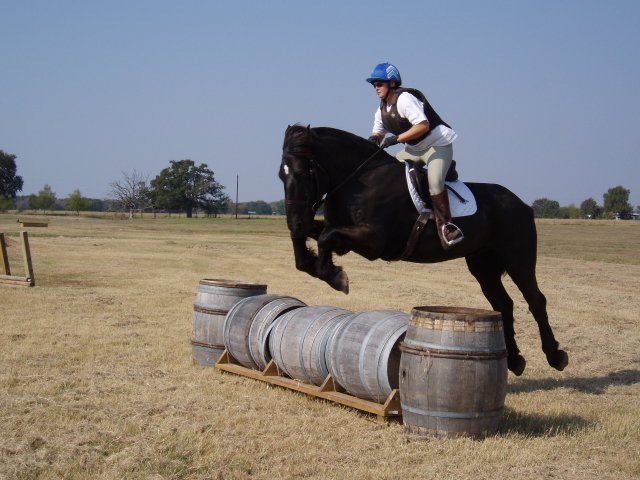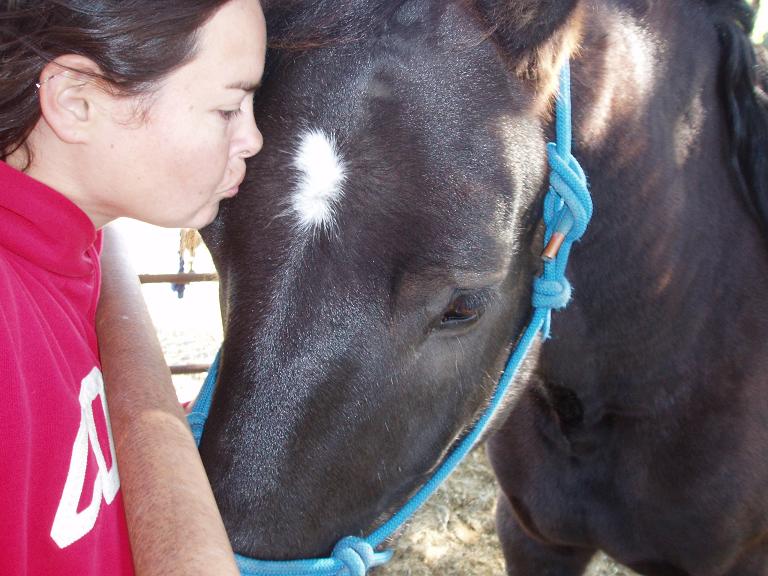Brego and I hit the road today. Since I knew we would be doing trot sets, I put him in his easy boots with a support pad to help with the concussion of the road. I love roading, I think it's an often overlooked piece of the conditioning puzzle.
Any good book or trainer will tell you more about conditioning than I can, but I can share with you some of the observations I have had while conditioning a draft horse that were slightly different. As with all horses, conditioning hard tissue and tendons takes much much longer than conditioning heart and lungs. Most people look at heart rate and respiration as THE conditioning parameters. To a large extent, they are the easiest to measure and they are important. But the hardest part about keeping a draft going in a fast sport is not heart and lungs, it's keeping them sound.
From what I have read, legging up, or conditioning bone, tendons, and connective tissue takes six months or more, depending on the horse. Conditioning heart and lungs takes about six weeks. That means that long before you add speed to push the heart rate up, you need to be riding long, slow miles over some pretty rough terrain to build up the legs. It also improves balance and body awareness while strengthening the stabilizer muscles. This is why I like roading. In my experience, walking and some trotting over hard surfaces really improves legging up. It stimulates dense bone growth. My last jumping trainer once told me that Brego's front tendons felt like bridge cables, huge, tight, and hard. That's a conditioning complement. Trotting endless circles in a sand arena, even in the correct intervals, will not build your horse from the hoof up. You have to get the miles in.
I rode Brego for a full year out on trails before I ever added speed. I would put 12-15 miles in a day at the walk with a little trotting, over very rocky terrain. In fact, I didn't add speed and heart and lung conditioning until just last year.
There's lots of information out there on interval training, especially for eventers and endurance riders. I think interval training does build heart and lungs faster and easier than just riding fast for a long time. So once you have a legged up horse, investigate some good interval recommendations from people a lot smarter than I. Incidentally, foxhunting, with its checks and gallops is great interval training (and very fun)!
The biggest problem for me, when I first got started trying to add speed, was that I was afraid to push Brego. He would be blowing after a few minutes of trotting and I thought he was done. What I have learned over time is that he blows, and he needs a recovery period, but that after five minutes, he was back to 100%. Brego comes off a jumping course blowing, but he's not exhausted. He's more than likely hot, and he just blows. The key is his recovery period. If he is not fully recovered in the desired time, I pushed him too far. If he is recovered in a minute, regardless of the how much sweat and foam and blowing, he was not pushed enough.
I mean, Training level eventers come home with Thoroughbreds completely lathered after a conditioning set. Sweat is not the indicator of over exertion. Recovery time is a better indicator. If he looks as bad ten minutes later as he did while we were working, something is wrong.
Heat is the biggest problem when conditioning a big muscled horse like Brego. For normal horses, humidity is like a 2x magnifier. For Brego, it's 10x. It could be 50 F, if it's humid, Brego can't cool down. If he can't cool himself, he can't recover. So again, the recovery is key, and I have to factor in the weather when taking note of his fitness.
I also keep Brego body clipped in some form or fashion all year. Right now he has a trace clip, but in the next month, we'll go to a full body. This improves his recovery time immensely. Brego has good legs, and he has a good strong heart, but he is just so HOT. So anything I can do to keep him cool while he works adds noticeably to his performance.
One other observation is that when Brego is fit, he recovers faster at a trot than at a walk. So I can use judicious trotting in our interval sets during the break to add to his legging while not pushing him too far cardiovascularly.
So to apply all this information to today's ride:
I make the assumption, when restarting after a long break, that I am starting at zero. So the first few conditioning rides won't even include cantering.
We went down the road and walked the loop in a neighborhood we would later trot. I wanted Brego to see everything and everyone to see him first. Then we trotted three 5 minute intervals with 3 minute breaks. During the first break, I watched his breathing until he recovered and so that set the length of the subsequent breaks. Since we were working on a hard surface, I let him set the speed within the gait, I only asked that he pushed up the hills. I didn't let him drag down on his forehand.
After the intervals, we walk/jogged back up to the farm. Brego was blowing very hard, but couldn't stay in a walk, he was very alert, jigging. Once we got into the barn, he suddenly seemed quite tired. I noticed he was sweating around his eyes and his respiration was high. I untacked him quickly and got him back outside, offering him a drink. Once out in the breeze, he perked up again. He was stifled in the barn and wanted a walk. I cooled him out and within five minutes he was completely cool and dry. So even though he was blowing and sweaty, I didn't push him too much during the ride. However, since we were on a hard surface, I am happy with the amount of work we did.
After I turned Brego out, he cantered around his field some more, just to flaunt that he was not tired. But for a moment, in the barn, he looked exhausted. He was just hot. So, I need to do more to cool him and will likely body clip him before too much longer. By the way, today was sunny, 50 F and about 35% humidity. He just has too much hair for his liking.
Brego showed me we are not starting at zero. He should bounce back into good form within the next six weeks.







